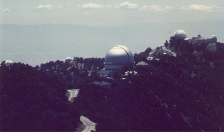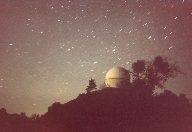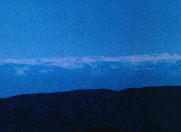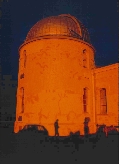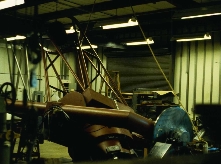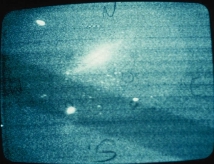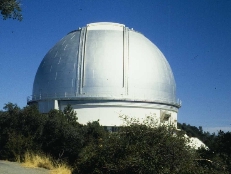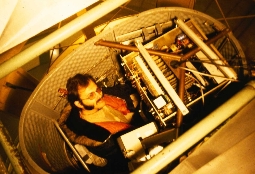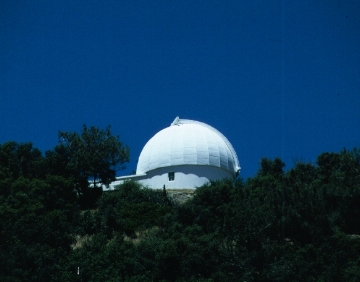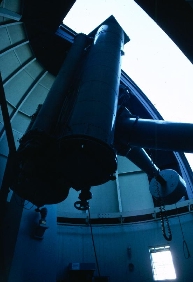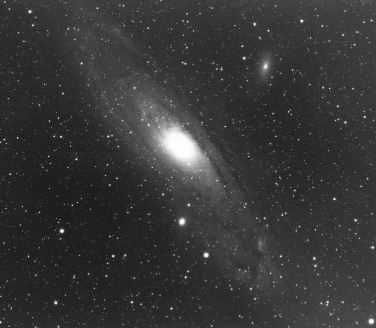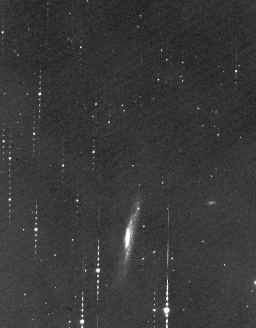Telescopes I've Used - Lick Observatory
Lick Observatory
(University of California), Mount Hamilton, California
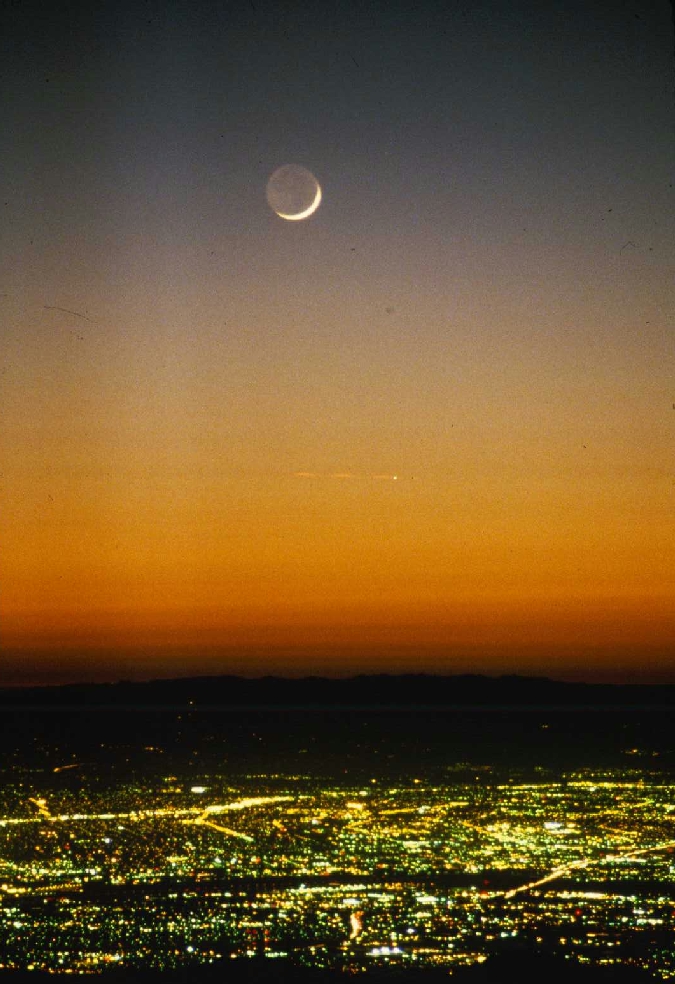 Lick
Observatory, long the primary astronomical facility for the entire University
of California system,
is where I did my graduate training, and much of my dissertation
research. Given its modest altitude of only about 4200 feet, the
mountaintop views are unusually
spectacular, including San Francisco Bay as far north as Mt. Tamalpais,
Monterey Bay, and on a clear day looking across the Central Valley, the Sierra
Nevada from near Mt. Whitney to well north of
Yosemite (that's Half Dome in the picture below). Of course,
I was most taken with the night-time views, especially
when San Jose was covered with fog. In the night-time view of the main
building with the 36-inch dome, that illumination isn't moonlight -
it's named after a newspaper, San Jose Mercury (the picture having been taken
in about 1980, just as the
switch to low-pressure sodium lighting was beginning). The sunset picture with
crescent Moon is pretty spectacular, but the city lights in foreground
can be alarming if you're trying to look deep into the Universe.
Lick
Observatory, long the primary astronomical facility for the entire University
of California system,
is where I did my graduate training, and much of my dissertation
research. Given its modest altitude of only about 4200 feet, the
mountaintop views are unusually
spectacular, including San Francisco Bay as far north as Mt. Tamalpais,
Monterey Bay, and on a clear day looking across the Central Valley, the Sierra
Nevada from near Mt. Whitney to well north of
Yosemite (that's Half Dome in the picture below). Of course,
I was most taken with the night-time views, especially
when San Jose was covered with fog. In the night-time view of the main
building with the 36-inch dome, that illumination isn't moonlight -
it's named after a newspaper, San Jose Mercury (the picture having been taken
in about 1980, just as the
switch to low-pressure sodium lighting was beginning). The sunset picture with
crescent Moon is pretty spectacular, but the city lights in foreground
can be alarming if you're trying to look deep into the Universe.
The overall view includes the main building with the original 36"
refractor and 1m Nickel reflector at far right, the 3m dome in the center,
and (in the distance) the Crossley dome to its left. The former home
of the 60-cm Boller and Chivens reflector
(now occupied by the
Katzman Automatic Imaging Telescope)
is at extreme left, much closer
than the others in this view from the east. The Carnegie astrograph is
hidden from this vantage point.
There is a USGS aerial image available from Terraserver.
The coordinate assignment is a bit off, so it takes
some fishing to find this for the first time. Possibly
more useful is the location on a
satellite image from
Google maps. Many of the same features are
seen in the following view from the window of an American Airlines Boeing
727 (the relevance being that 727s didn't have the engine
exhaust blurring the view behind each wing at low altitude). This is a view looking to the
northwest in early morning, including one of the frequent fogs that settle
below the
summit of Mt. Hamilton. The domes of the original
36" refractor (left, in the main building) and 120" Shane reflector (right) are
most prominent, with the Crossley telescope on the ridge to the lower
left of the main building and the double astrograph to the immediate left of
the Shane telescope.
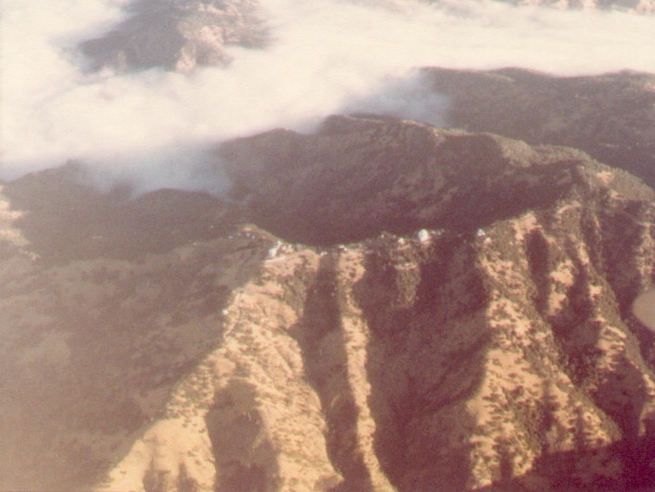
Mt. Hamilton is a popular tourist destinction, especially for sunset
watching. I couldn't resist this slightly impressionistic picture of some
viewers and their transportation in front of the Lick main building
one evening in the summer of 1980:
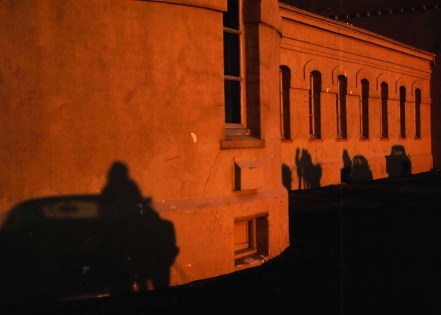
36-inch (0.9m) Crossley telescope
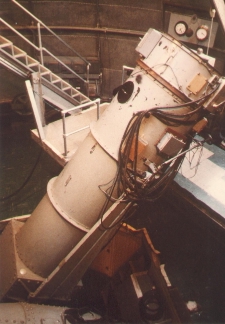
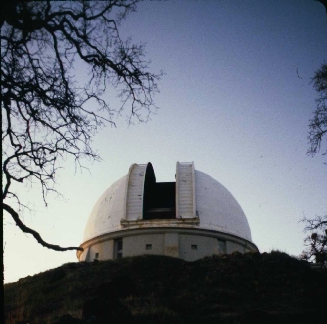
Telescopes sure can last. The Crossley was moved to Mount Hamilton from
England before 1895, and its "new" mounting dates to 1919. Still, I can't
recall any observing in which I took greater pleasure than direct photography
at the Crossley. The camera is at the f/5 prime focus with a guiding eyepiece
at the top of the tube, fed by a prism. You're right out there at the top of
the telescope on a platform in the middle of the open dome slit, with half the
sky (and all too frequently, all of San Francisco Bay) spread out before you.
Of course, in winter when it gets below freezing even near San Jose, I can't
recall any more miserable observing either.
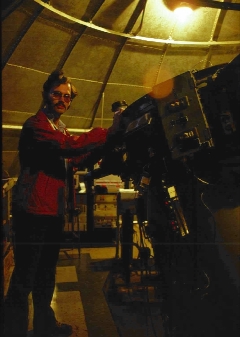 One major program I did at the Crossley was photographic monitoring of
variations in the
lensed double QSO 0957+561
over the couple of years after its
discovery - which led to my first solo paper in the Astrophysical Journal,
fittingly enough in the April 1, 1982 issue. I also did lots of galaxy
photography, for such purposes as astrometry to register optical and radio
structures (which was a bigger deal before the Digitized Sky Survey became
available, and each field had to
be individually measured and a separate plate solution computed for
every time the plate went on and off the measuring machine). The early
photographic archive (going back to 1895) allowed an unusual project, comparing
pictures of QSOs seen close to nearby galaxies with much older pictures to
look for the long-term variations in QSO brightness that some
gravitational lensing models would predict. Here are a few
blue-light Crossley photographs of galaxies, vintage 1980-1982, plus an
art shot of M17 in red light to fill the time as the summer Milky Way
interrupted the galaxy list. Exposures for the galaxies were 20-30 minutes
on 103a-O plates, while M17 was an hour on 103a-F red-sensitive emulsion.
One major program I did at the Crossley was photographic monitoring of
variations in the
lensed double QSO 0957+561
over the couple of years after its
discovery - which led to my first solo paper in the Astrophysical Journal,
fittingly enough in the April 1, 1982 issue. I also did lots of galaxy
photography, for such purposes as astrometry to register optical and radio
structures (which was a bigger deal before the Digitized Sky Survey became
available, and each field had to
be individually measured and a separate plate solution computed for
every time the plate went on and off the measuring machine). The early
photographic archive (going back to 1895) allowed an unusual project, comparing
pictures of QSOs seen close to nearby galaxies with much older pictures to
look for the long-term variations in QSO brightness that some
gravitational lensing models would predict. Here are a few
blue-light Crossley photographs of galaxies, vintage 1980-1982, plus an
art shot of M17 in red light to fill the time as the summer Milky Way
interrupted the galaxy list. Exposures for the galaxies were 20-30 minutes
on 103a-O plates, while M17 was an hour on 103a-F red-sensitive emulsion.
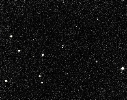 |
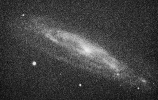 |
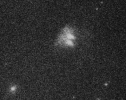 |
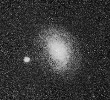 |
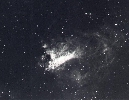 |
| Double quasar | NGC 4192 | Arp 220 | NGC 4800 | M17 |
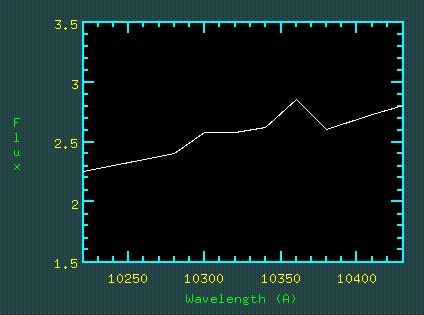 For a few special purposes, the original Wampler single-channel
spectrum scanner was around, which was one of the few instruments at the time
which could measure spectra just longward of one micron. As an example, here
are some spectral features of NGC 1068 in this region,
including reddening-sensitive [S II] emission lines.
For a few special purposes, the original Wampler single-channel
spectrum scanner was around, which was one of the few instruments at the time
which could measure spectra just longward of one micron. As an example, here
are some spectral features of NGC 1068 in this region,
including reddening-sensitive [S II] emission lines.
40-inch (1.0m) Anna Nickel telescope
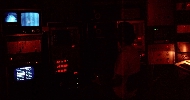
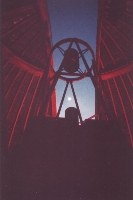 I arrived at UCSC just in time to follow the construction of the
Nickel telescope, from being
part of a grad course which made some minor changes to the design (if you've been
there, the elbows in the northern yoke supports were our contribution), through
preliminary mechanical assembly in the shops on campus, to pointing tests, and
jumped right in to be the first full-fledged Ph.D. project done on the
telescope. This telescope was based on an f/5 primary
mirror originally planned as a replacement for the Crossley's mirror,
but ended up in its own instrument, completely built in the Lick shops at
UCSC and pushed financially upon a bequest by Anna Nickel.
In all, I measured something like 700 spectra of about 200 galaxies,
plus a library of giant and main-sequence stars for spectral synthesis. The
1-m telescope was installed in the dome formerly occupied by the first
permanent telescope at Lick, the original 12-inch Clark refractor, at the north
end of the same building best known for the 36-inch refractor. By the time I
left UCSC in 1982, I had used about 10% of the dark time ever allocated on this
telescope (something I'm unlikely ever to manage again on an instrument that I
didn't pay for). I did make a point of patting
the mirror cell goodbye that final morning. This plot compares the spectrum of
galactic nucleus with a synthetic spectrum composed of nearby stellar
a examples, and the difference shows weak emission lines that are nearly lost
in the fine structure of the ordinary starlight spectrum.
I arrived at UCSC just in time to follow the construction of the
Nickel telescope, from being
part of a grad course which made some minor changes to the design (if you've been
there, the elbows in the northern yoke supports were our contribution), through
preliminary mechanical assembly in the shops on campus, to pointing tests, and
jumped right in to be the first full-fledged Ph.D. project done on the
telescope. This telescope was based on an f/5 primary
mirror originally planned as a replacement for the Crossley's mirror,
but ended up in its own instrument, completely built in the Lick shops at
UCSC and pushed financially upon a bequest by Anna Nickel.
In all, I measured something like 700 spectra of about 200 galaxies,
plus a library of giant and main-sequence stars for spectral synthesis. The
1-m telescope was installed in the dome formerly occupied by the first
permanent telescope at Lick, the original 12-inch Clark refractor, at the north
end of the same building best known for the 36-inch refractor. By the time I
left UCSC in 1982, I had used about 10% of the dark time ever allocated on this
telescope (something I'm unlikely ever to manage again on an instrument that I
didn't pay for). I did make a point of patting
the mirror cell goodbye that final morning. This plot compares the spectrum of
galactic nucleus with a synthetic spectrum composed of nearby stellar
a examples, and the difference shows weak emission lines that are nearly lost
in the fine structure of the ordinary starlight spectrum.
120-inch (3m) Shane telescope
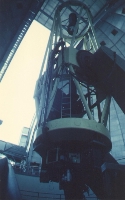
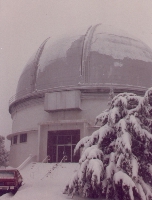 This telescope, starting from a glass blank used in testing the 200" Palomar
primary mirror, kept the University of California competitive in optical
and infrared astronomy with their neighbors to the south
up until the design of what became the Keck telescopes.
As far as I know, this is the smallest instrument in which observers routinely
worked in a prime-focus cage.
Okay, so the official UC policy at the time was that no grad students could
be
listed on the 120" schedule as the observers. I did manage a half-night in the
prime focus cage during the first checkout of a CCD spectrograph. The [O III]
emission lines really are an unearthly green, as I found when
finishing the night with
a calibration spectrum of NGC 7027 and telling the operator that I wasn't quite
ready to move the telescope until Nebula Appreciation class was over.
That very dim blob through the acquisition eyepiece really was
Cygnus A,
as we could tell when the spectrum came in. Ski
Antonucci and I did end up with a night of our very own - which was snowed
in, as photographically documented here.
This telescope, starting from a glass blank used in testing the 200" Palomar
primary mirror, kept the University of California competitive in optical
and infrared astronomy with their neighbors to the south
up until the design of what became the Keck telescopes.
As far as I know, this is the smallest instrument in which observers routinely
worked in a prime-focus cage.
Okay, so the official UC policy at the time was that no grad students could
be
listed on the 120" schedule as the observers. I did manage a half-night in the
prime focus cage during the first checkout of a CCD spectrograph. The [O III]
emission lines really are an unearthly green, as I found when
finishing the night with
a calibration spectrum of NGC 7027 and telling the operator that I wasn't quite
ready to move the telescope until Nebula Appreciation class was over.
That very dim blob through the acquisition eyepiece really was
Cygnus A,
as we could tell when the spectrum came in. Ski
Antonucci and I did end up with a night of our very own - which was snowed
in, as photographically documented here.
Carnegie 0.5-m (20-inch) twin astrograph
The Carnegie double astrograph was built for a single dedicated project - a
long-term astrometric study of vast numbers of stars, using distant,
faint galaxies as an inertial reference frame. This would yield
newly accurate information on galactic rotation and stellar populations.
The two objective lenses are best corrected for blue and yellow light,
so that both wavelengths can be observed simultaneously. The first epoch
of the survey began about 1947, with the second epoch of identical
exposures completed in the 1980s. The blue lens has an image structure
which grows rapidly to brighter magnitudes, which allows quite accurate
photometry, while the yellow lens gives very sharp Schmidt-like star images.
The survey observations used a wire grating over each objective, giving
a short set of diffracted spectral images to the north and south of bright
stars. This means that the positions of bright stars could be measured
precisely by averaging the diffracted images, instead of finding the center
of a huge overexposed blob. Since the survey exposures were long - two hours -
tracking was important, so the astrometrists at Lick would re-adjust the
polar axis to point at the appropriate refracted pole for each declination
band being observed. Furthermore, they also had to adjust its pointing
after each major earthquake in the area, to compensate for the slight rotation
of Mt. Hamilton as the two sides of the San Andreas fault complex slide
past each other.
As part of the graduate course on observing techniques, we each did practice
plates with the astrograph. These included
pictures of M31
(1 hour on 103a-O emulsion, blue astrograph -
stick with the classics, we thought), and later a field around the
double
QSO 0957+561 including the edge-on spiral NGC 3079
(1 hour on 103a-G with the yellow lens through cirrus),
showing the multiple images produced by the
objective gratings. The double quasar is near the upper right corner of
this excerpt, with NGC 3079 and its companion Markarian 131 near
the bottom. These were scanned from contact prints made from
the original 8x10" plates. Normal survey data were taken on still larger-format
plates, 20 inches square
and 1/4 inch thick. Only three astrometrists were allowed to handle
these.
Telescope Collection
Bill Keel's Home Page |
Astronomical Image Gallery |
Image Usage and Copyright Info |
UA Astronomy
keel@bildad.astr.ua.edu
Last changes: 4/2007 © 1999-2007
 Lick
Observatory, long the primary astronomical facility for the entire University
of California system,
is where I did my graduate training, and much of my dissertation
research. Given its modest altitude of only about 4200 feet, the
mountaintop views are unusually
spectacular, including San Francisco Bay as far north as Mt. Tamalpais,
Monterey Bay, and on a clear day looking across the Central Valley, the Sierra
Nevada from near Mt. Whitney to well north of
Yosemite (that's Half Dome in the picture below). Of course,
I was most taken with the night-time views, especially
when San Jose was covered with fog. In the night-time view of the main
building with the 36-inch dome, that illumination isn't moonlight -
it's named after a newspaper, San Jose Mercury (the picture having been taken
in about 1980, just as the
switch to low-pressure sodium lighting was beginning). The sunset picture with
crescent Moon is pretty spectacular, but the city lights in foreground
can be alarming if you're trying to look deep into the Universe.
Lick
Observatory, long the primary astronomical facility for the entire University
of California system,
is where I did my graduate training, and much of my dissertation
research. Given its modest altitude of only about 4200 feet, the
mountaintop views are unusually
spectacular, including San Francisco Bay as far north as Mt. Tamalpais,
Monterey Bay, and on a clear day looking across the Central Valley, the Sierra
Nevada from near Mt. Whitney to well north of
Yosemite (that's Half Dome in the picture below). Of course,
I was most taken with the night-time views, especially
when San Jose was covered with fog. In the night-time view of the main
building with the 36-inch dome, that illumination isn't moonlight -
it's named after a newspaper, San Jose Mercury (the picture having been taken
in about 1980, just as the
switch to low-pressure sodium lighting was beginning). The sunset picture with
crescent Moon is pretty spectacular, but the city lights in foreground
can be alarming if you're trying to look deep into the Universe.